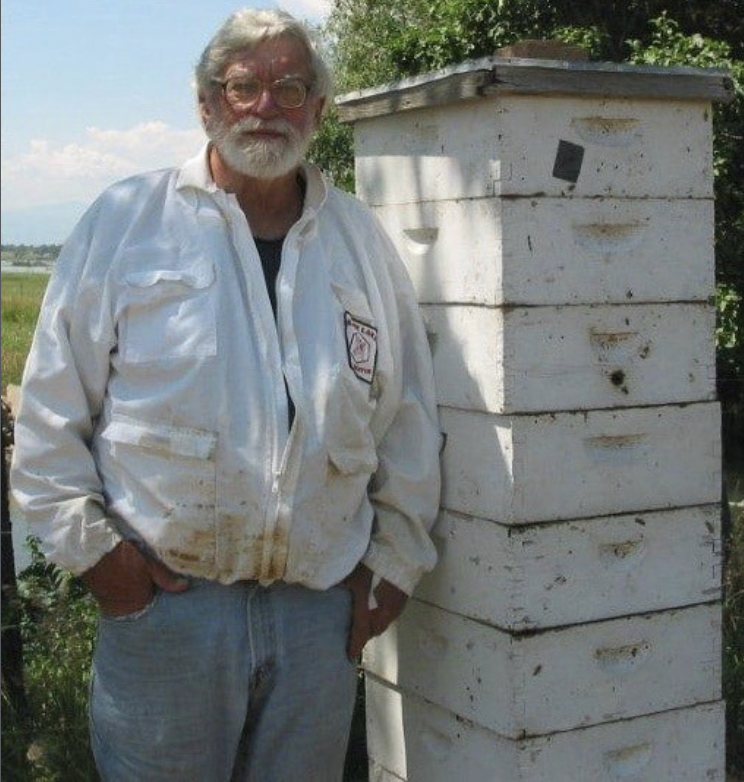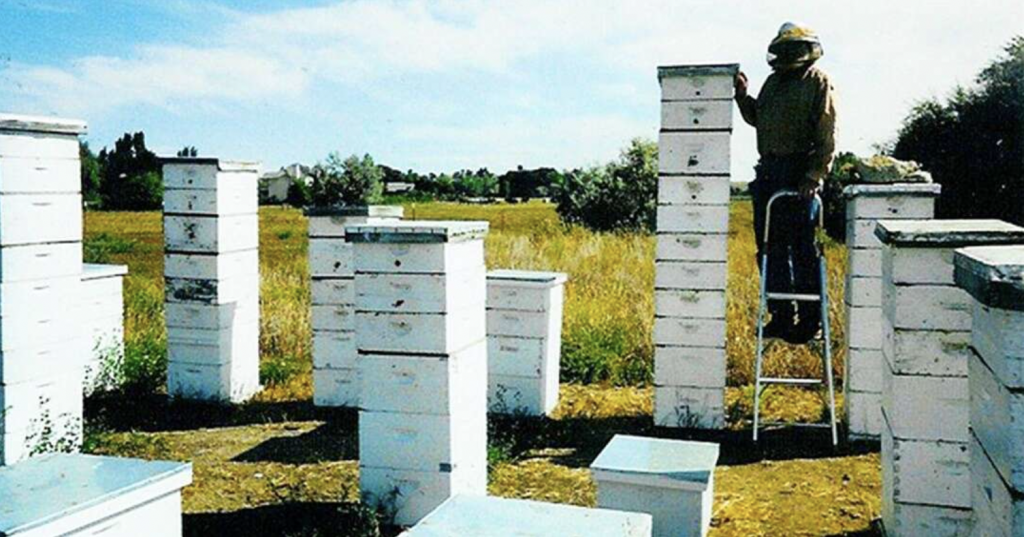
Alan Wade
Tom Theobald is the essence of beekeeping folklore.
Of a retrospective on Tom, Rachel Gabel writing from The FencePosti records Miles McGaughey, an early associate of Tom’s, saying that:
…he first knew of Theobald after he gave him a stern talking to regarding his speeding while McGaughey was a student at Niwot High School in the late 1970s.
McGaughey, also spooked by bees, noted that each beekeeping book he had borrowed from the Boulder Public Library had Tom Theobald’s name on the card as the other borrower. In a serendipitous way Miles also read of his regular column in The FencePost noting that
He was the last bee inspector in the state of Colorado and he did it all for free as a service to beekeepers… I always thought he was like the Bee Police, so I kind of kept my head down and avoided him.
Theobald was a great educator and established the Boulder County Beekeeping Association in 1984 to address pesticide issues in Boulder County. He established a network to warn local beekeepers of the Colorado Department of Agriculture sanctioned aerial spraying plans and took the US Environmental Protection Authority to task in their registration of pesticides that were lethal to bees. Clearly Miles and Tom later got on well, Rachel recording that:
He [Tom] and McGaughey trucked over 300 packages of bees from California, keeping the bees in Boulder County thriving after the hives were struck with Colony Collapse Disorder.
However it was for Tom Theobald’s penchant for operating unconventional two-queen hives that he is best remembered (Figure 1). McGaughey records that while most hives in the Boulder District produced a modest 40-80 pounds (18-36 kg) of honey annually, Tom’s two-queen hives were producing more like 400 lb (just over 180 kg) each year. Tom, though very much a solitary operator, was a great communicator also publishing in Bee Culture and in the American Bee Journal. Tom was passionate about bees.
Kim Flottum, editor of Bee Culture first brought to my attention this impressive two-queen Colorado beekeeper. In an apiary based 2003 interviewii Tom talks about how not to set up two-queen hives. He starts by reminding us that the introduction of a caged queen to a queenright colony will always result in the loss of the new queen. He then outlines his method, splitting a hive vertically and introducing a new queen to the upper queenless unit.
Once established, he replaced the division with a double screen, in turn replacing this with a queen excluder to establish a colony with two separate brood nests each with their own honey supers. The technique replicating that developed by Farrar shows in the live podcast how it was assembled detailing the method and pitfalls as well as the superior harvesting performance of the combined workforce compared with the equivalent workforce in two separate colonies. Running two queen hives, up to around 200 was his modus operandi.

Figure 1 Tom Theobald with one of his two-queen tower hives
He went on to explain that with the arrival of both the tracheal and external mites exacerbated by the accompanying pathogens, he was losing 30% of his colonies every winter curtailing the viability of his operation. Commercial beekeeping had become unviable at least for a beekeeper in Colorado unwilling to migrate his bees.
As outlined in a Beekeeping Today Podcast with Jeff Ott and editor of Bee Culture Kim Flottumiii in early January 2021 we are given a retrospective account of Tom’s operation (Figure 2):
Tom had a small commercial operation in Colorado in the late 70’s, running up to 200 or so colonies when he first started using two queen colonies. The biology of running two queens in a colony does make sense if you use the technique Tom perfected, but the better you get, the more lifting you are going to do. His finished production hives had three deeps for brood production and seven mediums for honey storage. At the time, an average to strong colony in his part of Colorado would make about 70 pounds of honey in a season, Tom’s two queen colonies averaged between 240 and 270 pounds!
The advantages, beside huge honey crops, were that these colonies started with last year’s queen, and a new, second queen was added in early spring. When the season was over, the new queen almost always prevailed, thus starting the next season with a proven queen. Plus, with a foraging population as large as these colonies produced, there was a vast store house of pollen the next spring for that season’s buildup.
Two-queen honey production is becoming a lost art as it takes a lot of work, timing and an understanding of your area’s nectar flows. However, the payoff is big! If you have bees in a location with lots of forage and not too much varroa or pesticide pressure, this approach may work for you.

Figure 2 Tom Theobald’s fully supered two-queen hives
In a retrospective of Tom’s apiary operationsiv we are told that:
…most hives produce 40 to 80 pounds (9-18 kg) of honey per season, but McGaughey – one of Tom’s life long associates – said one of Theobald’s two queen hives would produce upwards of 400 pounds (180 kg) per season.
The yields given are somewhat differ from those provided in Jeff Ott’s and Kim Flottum’s interview record with Tom: however the point is that the two-queen hives are very much more productive than equivalent pairs of single queen hives.
What we learn from Theobald’s scheme of beekeeping is that, while his honey season was short and sharp, with two queens and hives in optimal condition he could increase his crop severalfold.
Readings
iGabel, R. (13 November 2021). Telling the bees: Beekeeper Tom Theobald’s passing. The Fence Post https://www.thefencepost.com/news/telling-the-bees-beekeeper-tom-theobalds-passing/
iiTheobald, T. (31 July 2003). MROHP [Maria Rogers Oral History Program (Colorado)] Interviews: Tom Theobald (OH1157) Boulder Public Library. https://www.youtube.com/watch?v=q0uwZitB3_o
iiiOtt, J. and Flottum, K. (4 January 2021). Two queen honey production with Tom Theobald (S3, E32). Beekeeping Today Podcast: Bee Culture. https://www.beekeepingtodaypodcast.com/two-queen-honey-production-with-tom-theobald-s3-e32/ https://podcastaddict.com/episode/117841608
ivGabel, R. (13 November 2021) loc. cit.
